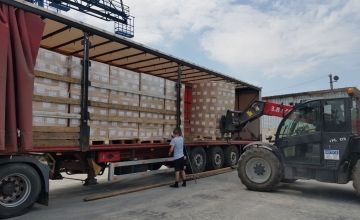
Knowledge Hub
Dam collapses in Ukraine, fuelling further humanitarian crisis

In the early hours of June 6, a power plant in southern Ukraine was severely damaged by explosions, causing water from the reservoir to flow violently downstream. 16,000 people have been affected so far, with concerns of contaminated water and evacuation needs increasing by the day.
The Nova Kakhovka Hydroelectric Power Plant is situated about 70km north of Kherson, where around 16,000 people are located in areas within the flooding zone. Water levels have risen by at least two meters in Kherson city and are predicted to continue to rise, possibly up to three meters.
So far, 1,300 people have been evacuated from the area. However, evacuations are limited, with the majority of people preferring to remain in Kherson city, in particular the elderly and those with mobility issues. Yet, with certain areas in Kherson losing electricity, an increase in humanitarian needs and continued evacuations over the coming days seem likely.
Major concerns for public health
Contamination of the water supply is a major concern throughout the region.
Furthermore, decreasing water levels in the reservoir will also have major impacts on water supplies in other urban centres not directly affected by the flooding. The Ministry of Social Protection of Ukraine reported that contaminated water, as well as other sources such as rabies-carrying wildlife displaced by the flood, are top concerns for public health.
Industrial facilities containing various hazardous substances, each with its own environmental and health risks, may have also been affected. They include ammonia, antibiotics, biodiesel, chlorine, isopropyl alcohol, kerosene, oils and solvents, and various petroleum products.

Current needs
The predominant needs for humanitarian assistance are:
- Watercrafts, life jackets, and children’s life jackets are very much needed to continue evacuating people from areas no longer accessible by land.
- Dry food rations, regular food packages, personal hygiene products, summer blankets, power banks, and flashlights have also been reported as top needs.
Water and water purification stations will also be urgent needs over the coming days.
Additionally, the risk of water scarcity in areas previously reliant on water from the reservoir is high – and could potentially develop into further significant humanitarian needs.
How Concern are helping
Last year, Concern joined with German non-government organisation Welthungerhilfe and Italian humanitarian organisation Cesvi to operate the Joint Emergency Response in Ukraine (JERU). The JERU team in the east is currently mobilising and engaging three partner organisations to deliver food and hygiene kits and possibly cash assistance to households displaced by the flooding.
The team has also pre-positioned around 9,000 food and hygiene stock ready to be deployed and is working with a partner to distribute food in Kherson for those who remain.
Donate to our Ukraine Humanitarian Appeal
Other ways to help
Donate now
Give a one-off, or a monthly, donation today.
Join an event
From mountain trekking to marathon running, join us for one of our many exciting outdoor events!
Buy a gift
With an extensive range of alternative gifts, we have something to suit everybody.
Leave a gift in your will
Leave the world a better place with a life-changing legacy.
Become a corporate supporter
We partner with a range of organisations that share our passion and the results have been fantastic.
Create your own fundraising event
Raise money for Concern by organising your own charity fundraising event.





